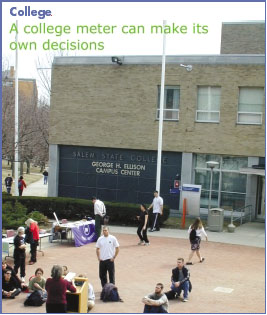Electric meters share this with children - They can earn more later if they have more education now. Ninety percent of electric meters have an elementary school education. They can read and write. Now suppose you send them to high school or college. What would you get back? This is not just an academic question. It is of critical concern on the West Coast where the droughts of 2000 have returned and utilities must purchase wholesale power to replace low cost hydro energy. In 2001, Idaho rate payers saw monthly bills rise 39% and the Federal Energy Regulatory Commission has found that the market manipulation exercised by wholesalers and traders cost the rate payers in California two billion dollars.
Smarter meters can mitigate market spikes by enabling consumers to respond to Time-of-Use tariffs and aggregate demand response. Public Utility Commissions in California and Idaho decided two years ago that some demand response is essential to discipline the wholesale market. Faced with peaking prices, a small amount of demand response can leverage prices down by a percentage ten times as great. Recognizing the value in “harnessing mice” for demand response, both PUCs embarked on studies aimed at implementing smart meters statewide. The cost for TOU meter systems would be $US 1.8 Billion for PG&E’s 4.7 million electric meters in California's and $US 72 Million for Idaho's 450,000 meters. 43% of the cost is in the meter, the balance is for communications capital, networking, and data management. Under the guidance of the PUCs, these costs and TOU tariffs would be added to regulated rates.
For two years, the CA and ID PUCs have studied every aspect of statewide AMR with at least daily TOU communications. They have cautiously approached the point of a decision which might see statewide AMR beginning in 2004. So what kind of metering, communications, networks, and controls have they been studying? One way to present their studies is to think of meters as having different levels of education and different expectations of return.
Elementary School Meter
It reads and writes. It costs about $US 40 plus about $US 1 a month for a walk around meter reader. They represent 90% of all meters. The 9% of meters who have reached middle school can talk once a month to a mobile van or use the telephone. They cost about $US 90 plus monthly reading cost.
High School Meter
Less than 1% of meters have finished high school but they are the focus of advanced AMR envisioned in CA and ID. They are networked and can tell you over the Internet what's going on at least once a day. They support TOU tariffs and demand response. They can also write reports and tell you how present consumption compares to history or how your building compares to similar buildings. They can tell you a lot about how you can reduce monthly electric bills and save money. They cost $145 plus about $5 month for cellular communications.
College Meter
This meter has left home. Best described as advanced AMR with energy controls, they have been deployed mostly in pilots. They can make their own decisions about many things. They can decide when and how to save money and they can do it for you. They are networked to real-time demand and supply systems and can operate digital energy controls based on the information they gather. They can respond to critical peak pricing signals and aggregate their response with thousands of others to balance the transmission system and reduce price spikes. They cost $700+ and require a broad band connection.
Taxpayers and parents spend $US 3,500 a year on elementary education per student, twice that for a high school student and ten times that for a private college. They wouldn’t spend this money without a return. So what is the return on educated metering?
High school The California Public Utilities Commission is evaluating networked meters for the entire state at a system cost of $US 160 at the meter and $US 220 for communications and networking. In February the Idaho PUC ordered Idaho Power to plan advanced metering throughout its service territory for a system cost of $US 160 per meter. The benefits of advanced metering with communications to the Internet are to support Energy Information Systems (EIS), Time-of-Use tariffs, peak load management, critical peak TOU, demand response, energy efficiency, and conservation. The PUCs identified benefits that flow individually to the consumer by providing information needed for lowering their bills and collectively to all ratepayers as a result of market response mitigating price spikes and reducing consumption of expensive peak power.
The California PUC study notes that just putting a meter on line can reduce energy consumption by 5%. This is the “discovery” effect when rate payers see a real load profile of what power they use and when. They frequently “discover” they don't need that extra refrigerator in the garage. On the commercial side, Leslie Lambert of Lambert Engineering says, “Most inefficiencies are invisible to management… Experience shows that 10% or greater savings often result from simply operating what you have more efficiently”. (Energy Pulse 2.25.03)
College A college trained meter combines Internet communications with intelligent control. A residential installation, typically over cable or power line carrier, costs about $700 and manages Time-of-Use tariffs, Critical Peak Pricing (CPP), and an air conditioning or electric heat thermostat. On the commercial side, the New York Energy Research and Development Authority provides grants up to $US 3500 for advanced commercial meters. One of the biggest pay backs is to enable critical peak pricing which can save significant sums for both the customer and the utility. In Idaho, the PUC estimates that critical peak pricing could save rate payers more than $US 1 million. Additionally, if just 25% of residential customers participated, the CPP system could reduce peak demand by 40 MW. Long term, according to studies cited by the PUC, “Idaho Power would have the potential to avoid $US 12 million per year in carrying charges for capital investment in peaking facilities” (IPUC 2/21/03)
Combining metering with communications and controls can reduce energy waste ten to fifteen percent. Coupled with Time of Use tariffs and incentives, the system can pay for itself in a year or two depending on market spikes. A residential system is aimed at managing heating or cooling in real time, especially during critical peak pricing episodes. Day to day, the management of heating and cooling through the afternoon peak demand period saves small amounts without any human involvement. The savings accumulate automatically. A commercial system manages coincident demand adjusting refrigeration, lighting, and HVAC through the daily peak and becoming especially smart during critical peak pricing incidents. A single soft drink vender using $30 month power can save $3 month simply by coasting through the daily demand peak and the midnight hours (reducing both peak kW and monthly kWh). College campuses have dozens of vending machines each potentially offering a ten percent saving. Bigger savings can be achieved by managing walk-in refrigeration, dimming office lighting on bright days, and managing co-incident demand of heating and air conditioning.
A college trained meter combines digital logic, communications, and energy control. Microprocessors in your meter managing air conditioning are relatively inexpensive compared to the cost of the energy flowing through the meter. The Internet, connected to control systems by cable or wireless, is the capstone paying dividends on a college education. Elementary school AMR captures benefits accruing to the retail electricity supplier. These benefits improve meter reading. High school meters capture benefits accruing to all the rate payers as everyone benefits from lower cost of peak power. The college meter captures benefits accruing to all the above and to the home owner or businesses by automatically timing the consumption of peak kilowatts and total kilowatt hours. Just like a college education, a baccalaureate meter will cost more in the short run, but will quickly pay for itself and return ten to twenty percent in energy savings by reducing waste.
About the Author
Gerald Mimno writes extensively on the value of interval data. He has many years experience with the technology of real-time AMR. Professionally, he is CEO of Advanced AMR Technologies LLC based in Peabody, MA. He encourages comments to gmimno@AdvancedAMR.com
Smarter meters can mitigate market spikes by enabling consumers to respond to Time-of-Use tariffs and aggregate demand response. Public Utility Commissions in California and Idaho decided two years ago that some demand response is essential to discipline the wholesale market. Faced with peaking prices, a small amount of demand response can leverage prices down by a percentage ten times as great. Recognizing the value in “harnessing mice” for demand response, both PUCs embarked on studies aimed at implementing smart meters statewide. The cost for TOU meter systems would be $US 1.8 Billion for PG&E’s 4.7 million electric meters in California's and $US 72 Million for Idaho's 450,000 meters. 43% of the cost is in the meter, the balance is for communications capital, networking, and data management. Under the guidance of the PUCs, these costs and TOU tariffs would be added to regulated rates.
For two years, the CA and ID PUCs have studied every aspect of statewide AMR with at least daily TOU communications. They have cautiously approached the point of a decision which might see statewide AMR beginning in 2004. So what kind of metering, communications, networks, and controls have they been studying? One way to present their studies is to think of meters as having different levels of education and different expectations of return.

Elementary School Meter
It reads and writes. It costs about $US 40 plus about $US 1 a month for a walk around meter reader. They represent 90% of all meters. The 9% of meters who have reached middle school can talk once a month to a mobile van or use the telephone. They cost about $US 90 plus monthly reading cost.

High School Meter
Less than 1% of meters have finished high school but they are the focus of advanced AMR envisioned in CA and ID. They are networked and can tell you over the Internet what's going on at least once a day. They support TOU tariffs and demand response. They can also write reports and tell you how present consumption compares to history or how your building compares to similar buildings. They can tell you a lot about how you can reduce monthly electric bills and save money. They cost $145 plus about $5 month for cellular communications.
College Meter
This meter has left home. Best described as advanced AMR with energy controls, they have been deployed mostly in pilots. They can make their own decisions about many things. They can decide when and how to save money and they can do it for you. They are networked to real-time demand and supply systems and can operate digital energy controls based on the information they gather. They can respond to critical peak pricing signals and aggregate their response with thousands of others to balance the transmission system and reduce price spikes. They cost $700+ and require a broad band connection.
Taxpayers and parents spend $US 3,500 a year on elementary education per student, twice that for a high school student and ten times that for a private college. They wouldn’t spend this money without a return. So what is the return on educated metering?
High school The California Public Utilities Commission is evaluating networked meters for the entire state at a system cost of $US 160 at the meter and $US 220 for communications and networking. In February the Idaho PUC ordered Idaho Power to plan advanced metering throughout its service territory for a system cost of $US 160 per meter. The benefits of advanced metering with communications to the Internet are to support Energy Information Systems (EIS), Time-of-Use tariffs, peak load management, critical peak TOU, demand response, energy efficiency, and conservation. The PUCs identified benefits that flow individually to the consumer by providing information needed for lowering their bills and collectively to all ratepayers as a result of market response mitigating price spikes and reducing consumption of expensive peak power.

The California PUC study notes that just putting a meter on line can reduce energy consumption by 5%. This is the “discovery” effect when rate payers see a real load profile of what power they use and when. They frequently “discover” they don't need that extra refrigerator in the garage. On the commercial side, Leslie Lambert of Lambert Engineering says, “Most inefficiencies are invisible to management… Experience shows that 10% or greater savings often result from simply operating what you have more efficiently”. (Energy Pulse 2.25.03)
College A college trained meter combines Internet communications with intelligent control. A residential installation, typically over cable or power line carrier, costs about $700 and manages Time-of-Use tariffs, Critical Peak Pricing (CPP), and an air conditioning or electric heat thermostat. On the commercial side, the New York Energy Research and Development Authority provides grants up to $US 3500 for advanced commercial meters. One of the biggest pay backs is to enable critical peak pricing which can save significant sums for both the customer and the utility. In Idaho, the PUC estimates that critical peak pricing could save rate payers more than $US 1 million. Additionally, if just 25% of residential customers participated, the CPP system could reduce peak demand by 40 MW. Long term, according to studies cited by the PUC, “Idaho Power would have the potential to avoid $US 12 million per year in carrying charges for capital investment in peaking facilities” (IPUC 2/21/03)
Combining metering with communications and controls can reduce energy waste ten to fifteen percent. Coupled with Time of Use tariffs and incentives, the system can pay for itself in a year or two depending on market spikes. A residential system is aimed at managing heating or cooling in real time, especially during critical peak pricing episodes. Day to day, the management of heating and cooling through the afternoon peak demand period saves small amounts without any human involvement. The savings accumulate automatically. A commercial system manages coincident demand adjusting refrigeration, lighting, and HVAC through the daily peak and becoming especially smart during critical peak pricing incidents. A single soft drink vender using $30 month power can save $3 month simply by coasting through the daily demand peak and the midnight hours (reducing both peak kW and monthly kWh). College campuses have dozens of vending machines each potentially offering a ten percent saving. Bigger savings can be achieved by managing walk-in refrigeration, dimming office lighting on bright days, and managing co-incident demand of heating and air conditioning.
A college trained meter combines digital logic, communications, and energy control. Microprocessors in your meter managing air conditioning are relatively inexpensive compared to the cost of the energy flowing through the meter. The Internet, connected to control systems by cable or wireless, is the capstone paying dividends on a college education. Elementary school AMR captures benefits accruing to the retail electricity supplier. These benefits improve meter reading. High school meters capture benefits accruing to all the rate payers as everyone benefits from lower cost of peak power. The college meter captures benefits accruing to all the above and to the home owner or businesses by automatically timing the consumption of peak kilowatts and total kilowatt hours. Just like a college education, a baccalaureate meter will cost more in the short run, but will quickly pay for itself and return ten to twenty percent in energy savings by reducing waste.
About the Author
Gerald Mimno writes extensively on the value of interval data. He has many years experience with the technology of real-time AMR. Professionally, he is CEO of Advanced AMR Technologies LLC based in Peabody, MA. He encourages comments to gmimno@AdvancedAMR.com







